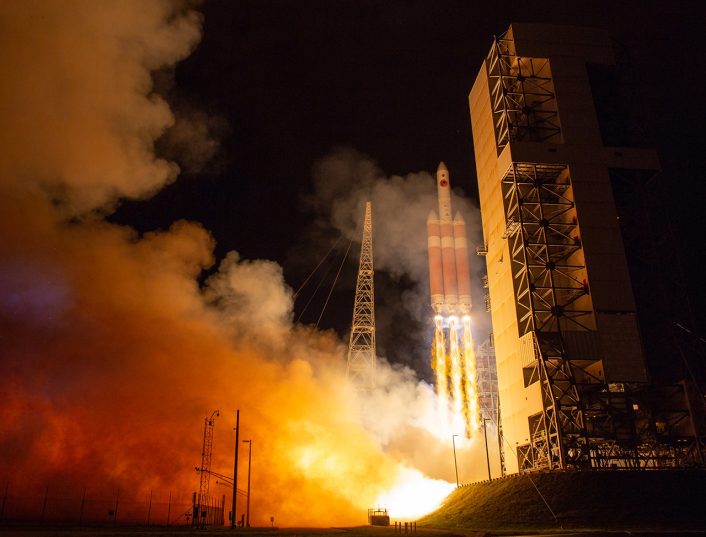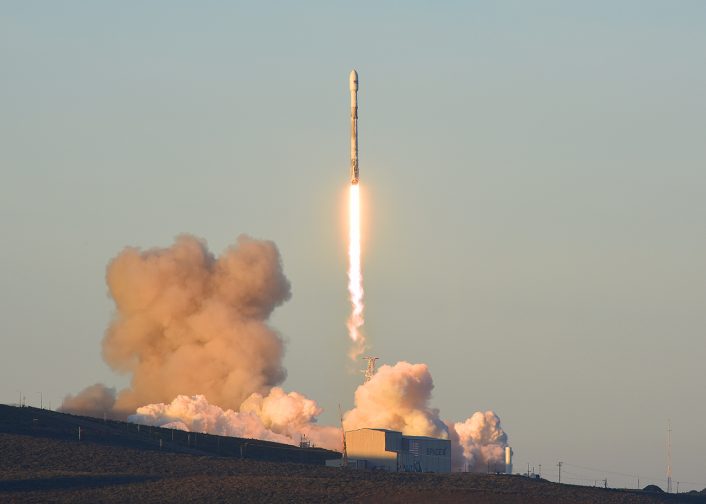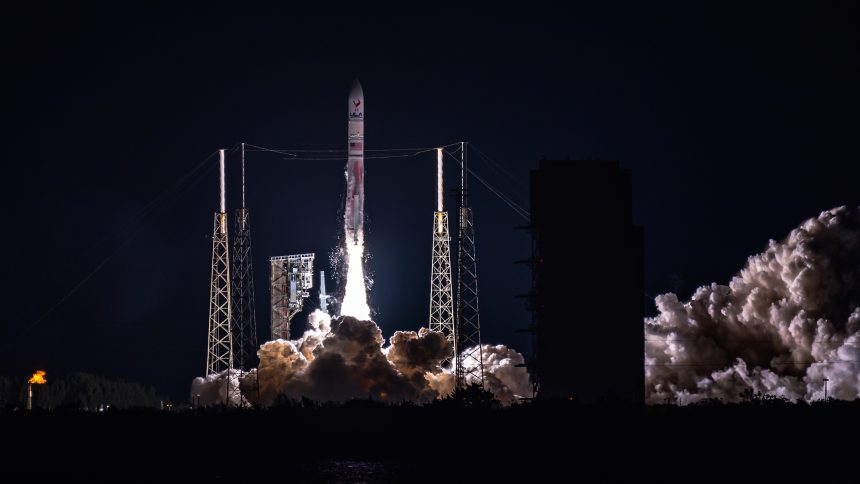United Launch Alliance’s Vulcan Centaur orbital launch vehicle will undertake its first National Security Space Launch (NSSL) mission next week, the rocket type’s third launch overall.
The two stage vehicle is scheduled to launch from Space Launch Complex 41 (SLC-41) at Cape Canaveral Space Force Station on Aug. 12, 2025 carrying the NTS-3 (Navigation Technology Satellite 3) technology demonstrator for the U.S. Air Force Research Laboratory (AFRL) to geosynchronous orbit. The rocket will also carry an unspecified classified payload on behalf of the U.S. Space Force (USSF).
Delayed several times to allow for the Vulcan Centaur rocket to enter service, the mission – designated USSF-106 – was most recently pushed back in October 2024 following a test launch that experienced a solid rocket booster (SRB) malfunction. The issue with the Northrop Grumman GEM-63XL booster did not impact the success of the flight, but did cause an asymmetric reduction in thrust output.
A wild anomaly occurred during the launch of ULA’s Vulcan CERT-2 mission this morning, with what appeared to be an SRB nozzle coming loose mid-flight.
📸 me for @SpaceflightNow pic.twitter.com/DhADlPQ5G6
— Adam Bernstein (@ABernNYC) October 4, 2024
The October anomaly delayed the certification of the Vulcan for NSSL launches, which was only eventually granted in March 2025. This certification requires launch vehicles to demonstrate high levels of reliability and redundancy in order to protect valuable military and government payloads from being lost in rocket failures as much as reasonably possible.
United Launch Alliance – a 50/50 joint venture between Boeing and Lockheed Martin – has previously offered their Atlas V and Delta IV rockets for NSSL launches. Delta IV flew its final mission in April 2024, while Atlas V has a number of launches remaining before retirement. The arrival of more cost effective, heavy launch vehicles like SpaceX’s Falcon Heavy saw the Delta IV become unattractive from a cost perspective, while the Atlas V’s use of the Russian-designed RD-180 engine is politically unsustainable.

Vulcan achieving its first successful national security launch will end the brief monopoly held by SpaceX for military and government space launches. NSSL certification is also sought by Blue Origin – founded by Amazon head Jeff Bezos – for their New Glenn orbital rocket. The second of the two required certification launches for New Glenn is planned for no sooner than Aug. 15. For both ULA and Blue Origin, the remaining challenge would be to compete with SpaceX’s incredible pace of launches – almost 100 successful Falcon 9 launches have taken place in 2025 alone.

Over-reliance on SpaceX, still headed by the controversial billionaire Elon Musk – who is in the midst of a very public falling out with U.S. President Donald Trump – has been a major cause for concern both inside and outside of the U.S. Government and military. Calls have been made across the political spectrum for the national security critical elements of the company to be seized by the U.S. Government in order to protect its security interests and investments. Alongside the company’s space launch vehicles, Starshield, a military-specific development of the Starlink satellite internet network, is seeing increased use within the U.S. military.
USSF-106 will be the inaugural flight for Vulcan’s VC4S configuration. Both previous launches have been in the VC2S configuration. The first two letters in the configuration name stand for Vulcan Centaur – a Vulcan main stage with a Centaur upper stage, while the number represents the number of SRBs fitted to the main rocket body. The last letter is either S or L, distinguishing the standard 15.5 metre payload fairing from the larger 21.3 metre payload fairing. Vulcan Centaur is able to be configured with 0, 2, 4, or 6 SRBs, with no odd-number asymmetric SRB configurations which were occasionally seen on Atlas V.
Atlas V does a power-slide!
The unique configuration and capabilities of the Atlas V’s RD-180 engine permit it to handle extreme asymmetric thrust from a single GEM-63 solid rocket booster. @torybruno #USSF8 #ULA #AtlasV
📷for @NSS pic.twitter.com/DifxRyXvHI
— Sean Cannon (@planetdeimos) January 21, 2022
Rocket Engines
Vulcan Centaur replaces the RD-180 main stage engine from the Atlas V with two Blue Origin BE-4 liquid fueled engines. These engines are also used for Blue Origin’s own New Glenn, though Vulcan had the honour of being the vehicle used for their first actual flight in January 2024. Rather than the kerosene based RP-1 fuel used by the RD-180, BE-4 uses a liquid methane fuel combined with the usual liquid oxygen oxidizer.
Each engine delivers 550,000 lbs of propulsive force at sea level. The RD-180, which is a twin-nozzle design with two combustion chambers sharing a single fuel turbopump system, provides around 860,000lbs of force at sea level, meaning a comparable configuration of two BE-4s exceeds the RD-180’s performance.
I spy a pair of BE4 engines about to go onto their booster for USSF106, #VulcanRocket ‘s first National Security mission. #CrowdedFactory pic.twitter.com/aU3fRciEEO
— Tory Bruno (@torybruno) May 29, 2024
Future demand expected from both the New Glenn and Vulcan rockets have resulted in two distinct BE-4 production lines being established. Like SpaceX’s vehicles, New Glenn is designed to have its main stage recovered and reused. Vulcan, however, is expendable and as such any engines used by the ULA vehicle will currently see one use only.
An upgrade is in development which would see the engine module separate from the stack after use and return safely to the ground using an inflatable heat shield, allowing the BE-4 engines to be recovered, refurbished, and re-used. This would bring down individual launch costs, which the company will hope will help to attract commercial customers currently enticed by the Falcon 9’s remarkably cost-effective offering.
The Centaur V upper stage, meanwhile, is effectively a tried and tested design, having been developed from the Centaur III used on Atlas V. New variants of the liquid hydrogen fueled RL10 engines provide additional thrust performance and efficiency.
NTS-3 Satellite
Developed by L3Harris, NTS-3 is described as the first experimental positional, navigation, and timing (PNT) satellite fielded by the U.S. in over 50 years. The satellite will trial new technologies intended to improve the survivability of PNT systems like the U.S. Global Positioning System (GPS) against emerging threats that aim to disrupt or deny real-time PNT for personnel, vehicles, and weapon systems.
Operating at a near-geosynchronous orbit, NTS-3 will use a phased array antenna to electronically steer and target transmitted signals to specific regions of the Earth. The operational period is expected to last for one year.

Part of NTS-3’s tests will involve the trialing of a PNT signal authentication protocol named CHIMERA. CHIMERA attempts to mitigate the threat of PNT data spoofing by establishing a secure, encrypted handshake procedure between the satellite and the receiving system which verifies the signal’s authenticity. Such a measure, once fully developed, would likely arouse the interests of commercial aircraft operators whose encounters with GPS jamming across Europe and the Middle East in recent years have been widely reported.
Modern developments with software defined radios (SDRs) will be leveraged to allow the satellite’s transmission parameters to be changed rapidly while on-orbit. Not only would this permit the real-time mitigation of jamming and spoofing attacks by simply switching to new frequencies, but it also provides for the possibility of backwards and forwards compatibility with other systems.
In the future, a widespread roll out of advanced SDR technology on board satellites could mean that more frequent, iterative upgrades to services previously rendered impossible by the immense cost of replacing entire satellite networks are now feasible endeavors.









